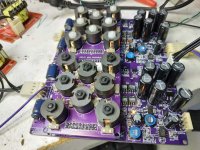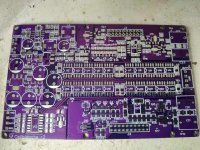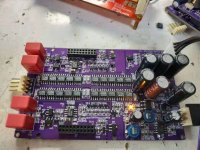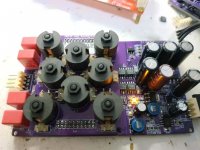Err, nope mate, I was actually serious... for once, happens sometimes 🙂
I believe the way you want to tackle it (increasing voltage to reduce distorsions, paralleling the OPS to deal with the resulting power disspation and if not good then going SOT-223) seems to make sense.
As amazing as it may sound, I DO actually read you GLOL!
Have a nice day
Claude
I believe the way you want to tackle it (increasing voltage to reduce distorsions, paralleling the OPS to deal with the resulting power disspation and if not good then going SOT-223) seems to make sense.
As amazing as it may sound, I DO actually read you GLOL!
Have a nice day
Claude
Last edited:
It makes no sense to me at all, but I am enjoying reading it anyway. 🙂
I am hoping that one day it might.
I am hoping that one day it might.
r1 PCBs came in a few days ago, but its taken me longer than usual to get an r1 prototype into a condition where prolonged listening is possible. I've been plagued with randomly occurring rumbling/rushing noise on the L channel. I was really hoping that it wasn't one of the DAC chips as individually examining (potentially isolating) one chip at a time is a long process. In the end the noise became less intermittent so became easier to track down. Eventually I uncovered a failed transistor in one of the biassing current sources.
So now comparative listening with the last version is possible. There's a lower impedance filter on the r1 to suit the additional current out of the DACs. Plus the tweaks to the discrete OPS on the I/V. Then after that, I am curious to try if its possible to push this to 60 chips......😱
So now comparative listening with the last version is possible. There's a lower impedance filter on the r1 to suit the additional current out of the DACs. Plus the tweaks to the discrete OPS on the I/V. Then after that, I am curious to try if its possible to push this to 60 chips......😱
Attachments
Bloody hell, failed transistor, that is really bad luck
Good on you you could trace it !
Lets us know your findings... and I won't comment on the 60 chip monster LOL.
Was there a conductor names Quasimodo?
Claude
Good on you you could trace it !
Lets us know your findings... and I won't comment on the 60 chip monster LOL.
Was there a conductor names Quasimodo?
Claude
r1 PCBs came in a few days ago, but its taken me longer than usual to get an r1 prototype into a condition where .....
Looks like a killer!
I am curious to try if its possible to push this to 60 chips......😱
The second prototype I built with 60 chips and set up a listen for wifey to see if she heard any difference. She seemed to have no trouble picking the 60 chip version against the 40 chip one, saying it was 'more powerful, more scary'.
So this result suggests the bottleneck is still in the DAC chips themselves. But this design isn't really a practical avenue for adding more chips beyond 40, I think I'm going to have to revisit my 'massively parallel multibit misadventures' design and see where that leads.
Oh and something very weird - the same transistor blew up as on the last prototype. Which suggests its a layout or circuit issue rather than just a random transistor failure. So more investigation is called for.
Hi Everyone.
I'm New Here. Heard Phi Deca DAC Today. Wanted to Know More About It. Where Can I Read About It & Perhaps Order It?
Can Anyone Help Me?
Thanks.
I'm New Here. Heard Phi Deca DAC Today. Wanted to Know More About It. Where Can I Read About It & Perhaps Order It?
Can Anyone Help Me?
Thanks.
Hi - you can find the commercial thread here : PhiDAC hex kits with pre-built filters
If you have technical questions then feel free to ask here, questions related to purchasing are better asked on the thread in the Bazaar.
If you have technical questions then feel free to ask here, questions related to purchasing are better asked on the thread in the Bazaar.
Thank You for Your Response.
Is There Any Place I can Order this DAC Pre-Built & Ready to Use?
I Don't Have Any Knowledge of Electronics or How to Assemble a DAC from the Kit for this DAC.
Also, DAC with 60 Chips Looks So Interesting.
Is There Any Place I can Order this DAC Pre-Built & Ready to Use?
I Don't Have Any Knowledge of Electronics or How to Assemble a DAC from the Kit for this DAC.
Also, DAC with 60 Chips Looks So Interesting.
You can order by sending me a PM with your requirements, your location and your payment and shipping preferences. You can buy a Deca DAC PCB fully built and tested if SMD soldering isn't your strong point.
The 60 chip DAC won't be a commercially available project, its just for experimenting. Shortly there will be the 'Celibidache' available with 20 chips (with option for 40). It'll be more expensive than Deca DAC.
The 60 chip DAC won't be a commercially available project, its just for experimenting. Shortly there will be the 'Celibidache' available with 20 chips (with option for 40). It'll be more expensive than Deca DAC.
It is such a pity that you are so far away!!! (Or is it me who is far away, LOL?)
You are trying so many interesting things and there are so many variables, it is fascinating!
To point in the right directions efficiently it would probably make things sooo much easier to be able to compare all these developments to a settled baseline. I have on hand the D70S and a state of the art old DAC, both quite close re sound and giving an idea of what D-S DACs can produce in terms of details and musicality on 16/44.1 material. Perhaps the very last top $$$ DACs are better for high resolution files, no clue, and at that level of detail it is quite secondary IMHO - all these are VG... and good enough re classic ingineer's parameters, musicality and possibly flavour are far more relevant at that level to decide.
Playing with all these would make it easy to define a path... to equal or beat these conventional DACs at their own game, while of course adding the unique flavour that defines your DACs...
If only you would be next door, we would have nice listening sessions of all these 🙂
Thanks for sharing all your developments
Claude
You are trying so many interesting things and there are so many variables, it is fascinating!
To point in the right directions efficiently it would probably make things sooo much easier to be able to compare all these developments to a settled baseline. I have on hand the D70S and a state of the art old DAC, both quite close re sound and giving an idea of what D-S DACs can produce in terms of details and musicality on 16/44.1 material. Perhaps the very last top $$$ DACs are better for high resolution files, no clue, and at that level of detail it is quite secondary IMHO - all these are VG... and good enough re classic ingineer's parameters, musicality and possibly flavour are far more relevant at that level to decide.
Playing with all these would make it easy to define a path... to equal or beat these conventional DACs at their own game, while of course adding the unique flavour that defines your DACs...
If only you would be next door, we would have nice listening sessions of all these 🙂
Thanks for sharing all your developments
Claude
To handle the 20mA+ current swing out of the DACs with more thermal headroom, I decided to upgrade the transistors doing heavy lifting to SOT-89 types (PXT2907A).
Great looking board. I suppose we could stack 2 of them to make a balanced output?
You can indeed stack them to give yourself a balanced output DAC. There's a digital phase inversion function to create the -ve phase. I did create a balanced DAC with a total of 80 chips that way.
- Home
- Source & Line
- Digital Line Level
- lingDAC - cost effective RBCD multibit DAC design



